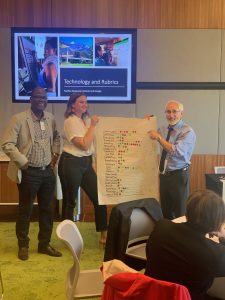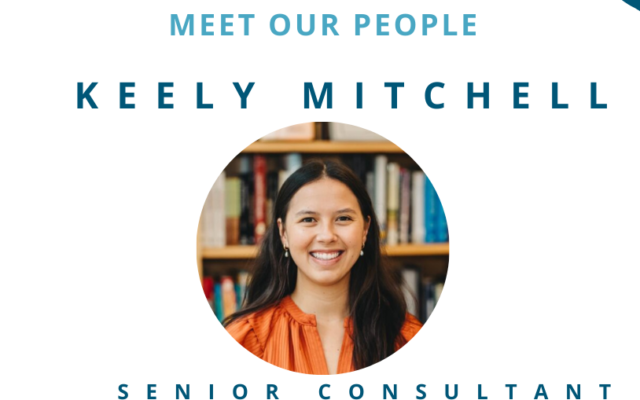
Building trust through empowerment evaluation
Doing great evaluation work depends on our ability to rapidly build trust and credibility. But being trustworthy and credible doesn’t mean being the expert. Now more than ever, we’re being asked to use what we know about evaluation to support communities and organisations to plan and evaluate their responses to Covid-19.
There’s a growing role for empowerment evaluation in this context.
In our most recent Business as Unusual interactive workshop, we were joined by international guest speaker and founder of the empowerment evaluation approach, Dr David Fetterman.
The theory: What is empowerment evaluation and when is it suitable?
Empowerment evaluation is the use of evaluation concepts, techniques and findings to foster improvement and self-determination. When evaluations are empowering, the probability that programs will be successful increases. The likelihood of success increases in part because the more people are involved in doing evaluations, the more likely they will find the results credible and act on the recommendations. Empowerment evaluation acts to align the theories of action with the theories of use. It is underpinned by the principles of social justice, accountability, inclusion and capacity building.
You can listen to David describe the theory of empowerment evaluation here.
The practice: How do you “do” an empowerment evaluation?
The ‘secret sauce’ of empowerment evaluation is its simplicity. There are three steps, which can be equally well-done face to face or virtually. You can listen to David summarise those three steps here.
Done face to face, David’s approach uses butchers paper and sticky dots as tools for decision-making and planning. He’s also discovered that online tools such as Google Sheets work just as well for groups collaborating remotely.
Step 1: MISSION
The first step is to identify your mission statement(s). David reiterated the importance of this step in the process, noting that facilitators should allow up to an hour for it. He noted that spending time to establish an agreed mission is important even when an agency or group has an already-defined mission: the democratic process of empowerment evaluation tends to draw out particular aspects, angles or the meaning behind the mission not captured ‘on paper’.
Step 2: TAKING STOCK
 Next, participants list all the activities required to make the agreed mission possible. These activities should be specific and achievable, not broad and hard to ‘tick off’. For example, to achieve our mission of ‘adapting to Covid-19’, participants suggested activities like putting hand sanitiser at key contact points, developing a roster for staff being in the office and providing additional mental health support services.
Next, participants list all the activities required to make the agreed mission possible. These activities should be specific and achievable, not broad and hard to ‘tick off’. For example, to achieve our mission of ‘adapting to Covid-19’, participants suggested activities like putting hand sanitiser at key contact points, developing a roster for staff being in the office and providing additional mental health support services.
The group then prioritises the 10 most important activities. In face to face workshops, this can be done with sticky dots. You can achieve the same result virtually using the free Google Sheets template that David has set up. Normally David allows 60 to 90 minutes for this process. At this stage, the evaluator’s role is to step back and allow the participants to share their actions and suggestions – no matter how big or small or how abstract they seem to be.
Participants can then rate how well the group is doing in each of the 10 chosen activities. The facilitator’s role in this process is to check in with participants to see why they assigned a particular rating. David suggested focusing on the clear contrasts—activities where some people see things going well and others see activities not being done very well at all, or at least in a less than optimal manner—as well as the concordance. There’s value in understanding any underlying differences between ratings that are, on the surface, the same: every person has a different reason for their rating.
Step 3: PLAN FOR THE FUTURE
Once actions have been listed and rated, future planning can commence. Participants can build on each action by determining goals and strategies to achieve each one. It’s important to determine how progress or achievement will be measured and understood. This step includes setting up evaluation dashboards with goals, strategies, evidence and timelines to enable ongoing monitoring and reporting of progress against milestones and goals.
The reflections: How empowerment evaluation adds value
We were fortunate to have time to ask David questions about how he’s applied empowerment evaluation over his many years of practice. Here are some of his key insights, which he further explains in this video.
- Hear from everyone with an opinion. Deliberately broaden out the audience beyond the usual suspects (program managers, administrators or executive). The democratic nature of the process means that everyone can offer their opinion and, in David’s experience, some of the greatest insights come from the people who are usually not asked to share their opinion.
- There’s no loss of control. Opening up the conversation doesn’t mean senior leaders lose control: in fact, almost the opposite is true. Using the empowerment approach means everyone has a role in choosing the priority actions and, because they were involved in setting the direction, are more likely to work towards achieving the organisation’s goals. This is a win for everyone.
- Reframing the challenge. Rather than focusing on negative or challenging aspects of a program or organisation, use empowerment evaluation to identify and discuss what is working well. This can be leveraged to make things work even better and then used be used to discuss things that are not working as well.
Final thoughts
It was a privilege to hear from such an experienced evaluator who, in closing, laid bare an important reminder for evaluators. David noted that Covid-19 has the potential to reinforce disadvantage: our job is to leave no one behind.
In our next Business as Unusual interactive online workshop, we will be joined by an expert panel to discuss what equity in evaluation means in the current context. The workshop will be held on Wednesday 3 June 2020 at 11:30am. Register here.




